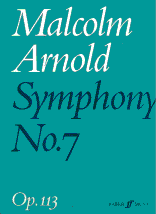
The Symphony No. 7, Op. 113 by Malcolm Arnold was finished in 1973. It is in three movements:
Contents
- Allegro energico ("Katherine")
- Andante con moto – Molto vivace – Lento ("Robert")
- Allegro – Allegretto – Allegro – Allegretto – Allegro ("Edward")
The score was largely written at Sir William Walton's home La Mortella on Ischia. Each movement is a portrait of one of his three children, to whom the work is dedicated. The work was commissioned by the New Philharmonia Orchestra.
It was premiered by the composer on 5 May 1974 with the New Philharmonia Orchestra at the Royal Festival Hall.
As of 2016 [update] , the manuscript is on deposit in the library of Eton College, having been discovered by Arnold's daughter for sale on eBay. [1]